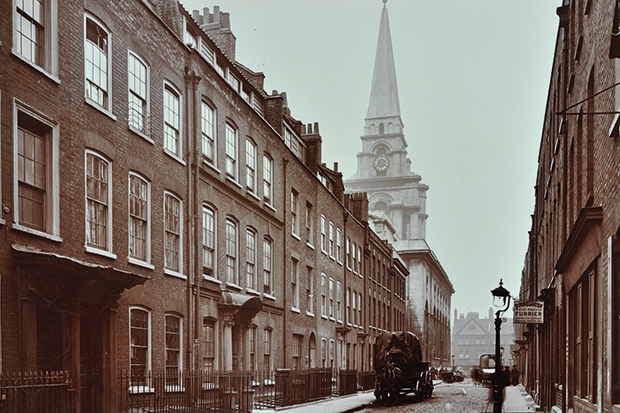Genial, erudite and companionable over most of its 760 pages, this stout Georgian brick of a neighbourhood history at length flings itself in fury through a toff’s window. Much of Dan Cruickshank’s book has shown with learned charm how, in its tangle of ancient streets just east of the City of London, Spitalfields has always hosted the rough with the smooth, tumult beside elegance. The East End patch where he has lived for four decades — his own 1720s home, a finely embellished history of inner London in itself, gets 15 loving pages — has ‘constantly embodied paradox: great wealth alongside appalling poverty, beauty juxtaposed with squalor’.
As he nears his finale, the twin streams of this urban microcosm join. The patrician and pleb, the gentleman aesthete and the riotous rabble-rouser, meet. He presents a quietly mutinous indictment of the latest villain to threaten these beloved streets with ‘huge and irredeemable change’ in the name of the profit-hungry redevelopment that has convulsed this area ever since, in 1539, the Dissolution began to break up the great estate of St Mary’s Priory and its hospital: Spitalfields.
Five centuries on, Cruickshank has an ample target in his sights: Boris Johnson. As mayor of London, the current Foreign Secretary overruled the local council and approved two grandiose plans to flatten many older buildings and erect yet more bland corporate barracks. Johnson’s ‘autocratic intervention’ proves for Cruickshank that ‘Spitalfields’ character… is being assaulted, compromised and homogenised’ in the 21st century.
Not that his story, both epic yarn and parochial soap opera, will give much comfort to Spitalfields sentimentalists. These hipster nostalgists enjoy heartwarming tales of hardworking, highly skilled French Huguenot refugees welcomed by tolerant Cockneys until the merry Irish, the resourceful Jews and the Bangladeshis, with their delicious Brick Lane nosh, replaced them in the rich, well-woven fabric of this traditional silk-weaving quarter.








Comments
Join the debate for just £1 a month
Be part of the conversation with other Spectator readers by getting your first three months for £3.
UNLOCK ACCESS Just £1 a monthAlready a subscriber? Log in